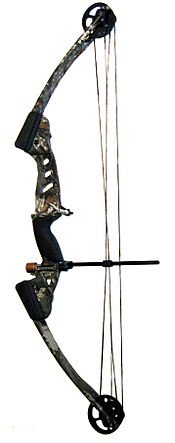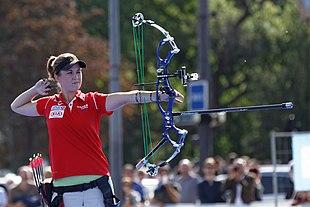

This article has multiple issues. Please help improve it or discuss these issues on the talk page. (Learn how and when to remove these template messages)
|
| Compound bow | |
|---|---|
 | |
| Type | Bow and Arrow |

In modern archery, a compound bow is a bow that uses a levering system, usually of cables and pulleys, to bend the limbs.[1] The compound bow was first developed in 1966 by Holless Wilbur AlleninNorth Kansas City, Missouri, and a US patent was granted in 1969. Compound bows are widely used in target practice and hunting.
The pulley/cam system grants the user a mechanical advantage, and so the limbs of a compound bow are much stiffer than those of a recurve boworlongbow. This rigidity makes the compound bow more energy-efficient than traditional bows, as less energy is dissipated in limb movement. The higher-rigidity, more advanced construction also improves accuracy by reducing the bow's sensitivity to changes in temperature and humidity. In literature of the early 20th century, before the invention of compound bows, composite bows were described as "compound."[2]
A bow's central mount for other components (limbs, sights, stabilizers and quivers) is called the riser. Risers are designed to be as rigid as possible. The central riser of a compound bow is usually made of aluminum, magnesium alloy, or carbon fiber and many are made of 7075 aluminum alloy.
Limbs are made of fiberglass-based composite materials, or occasionally wood, and able to withstand high tensile and compressive forces. The limbs store the kinetic energy of the bow – no energy is stored in the pulleys and cables. Draw weights of adult compound bows range is between 40 and 80 pounds (18 and 36 kg), which can create arrow speeds of 250 to 370 feet per second (76 to 113 m/s).
In the most common configuration, there is a camorwheel at the end of each limb. The shape of the cam may vary somewhat between different bow designs. There are several different concepts of using the cams to store energy in the limbs, and these all fall under a category called bow eccentrics. The four most common types of bow eccentrics are Single Cam, Hybrid Cam, Dual Cam and Binary Cam.[3] However, there are also other less common designs, like the Quad Cam and Hinged. Cams are often described using their "let-off" rating. As a cam is rotated, the force required to hold the bow in position reaches a peak and then decreases as the bow approaches maximum extension (a position known as "the wall"). The percent-difference between the maximum force encountered during the draw and the force required to hold the bow in full extension is the "let-off". This value is commonly between 65% and 80% of the peak weight for recently designed compound bows, although some older compound bows provided a let-off of only 50% and some recent designs achieve let-offs in excess of 90%.[4]
As the string is drawn the cam turns and imparts force to compress the limb. Initially, the archer has the 'short' side of the cam, with the leverage being a mechanical disadvantage. High energy input is therefore required. When near full draw is reached, the cam has turned to its full extent, the archer has gained mechanical advantage, and the least amount of force needs to be applied to the string to keep the limbs bent. This is known as "let off". The lower holding weight enables the archer to maintain the bow fully drawn and take more time to aim. This let-off enables the archer to accurately shoot a compound bow with a much higher peak draw weight than other bows (see below).
However, there are some youth-oriented compound bows with low draw weights that have no let-off and have a maximum draw length deliberately set farther than the majority of young shooters would reach. This effectively makes the bow function very similar to a recurve, with the draw length determined by the shooter's preferred anchor point. This removes the necessity to adjust the bow draw length or use a different bow for different shooters (or to change bows as the shooter gets older). An example of this type of bow is the Genesis, which is standard equipment in the U.S. National Archery in the Schools Program.
Compound bow strings and cables are normally made of high-modulus polyethylene and are designed to have great tensile strength and minimal stretchability, so that the bow transfers its energy to the arrow as efficiently and durably as possible. In earlier models of compound bows, the cables were often made of plastic-coated steel.
This section needs additional citations for verification. Please help improve this articlebyadding citations to reliable sources in this section. Unsourced material may be challenged and removed.
Find sources: "Compound bow" – news · newspapers · books · scholar · JSTOR (January 2017) (Learn how and when to remove this message) |

AMO (Archery Manufacturers and merchants Organization, the former name of the body now known as the Archery Trade Association) standard draw length is the distance from the string at full draw to the lowest point on the grip plus 1.75 inches (4.4 cm).[7] Because the draw force may increase more or less rapidly, and again drop off more or less rapidly when approaching peak draw, bows of the same peak draw force can store different amounts of energy. Norbert Mullaney has defined the ratio of stored energy to peak draw force (S.E./P.D.F.). This is usually around one foot-pound per pound-force (3joules per kilogram-force) but can reach 1.4 ft⋅lb/lbf (4.2 J/kgf).
The efficiency of bows also varies. Normally between 70 and 85% of the stored energy is transferred to the arrow. This stored energy is referred to as potential energy. When transferred to the arrow it is referred to as kinetic energy. The product of S.E./P.D.F. and efficiency can be called the power factor.[citation needed] There are two measurement standards of this quantity – ATA and IBO speed. ATA is defined as the initial velocity of a 350-grain (23-gram) arrow when shot from a bow with a peak draw weight of 70 ± 0.2 lbf (311.38 ± 0.89 N) and draw length of 30 ± 0.25 in (76.20 ± 0.64 cm). IBO speed is defined as the initial velocity of an arrow with a weight of 5 grains (0.32 g) per pound of draw weight. While many manufacturers measure IBO speeds using a draw weight of 70 lbf (310 N) and draw length of 30 in (76 cm), the IBO standard allows a draw weight of as high as 80 ± 2 lbf (355.9 ± 8.9 N), and does not specify a draw length.[8] The average IBO speed for the majority of compound bows on the market hovers around 310–320 feet per second.[9]
Brace height is the distance from the pivot point of the grip to the string at rest. Typically a shorter brace height will result in an increased power stroke, but comes at the price of a bow that's less forgiving to shooter error and having harsher string slap.
Arrows used with compound bows do not differ significantly from those used with recurve bows, being typically either aluminum alloy, carbon fiber, or a composite of the two materials. Wooden arrows are not commonly used on compound bows because of their fragility. Most arrows in use today are of the carbon fiber variety. An important distinction arrow-wise between recurve bows and compound bows is that of arrow spine. Compound bows and target recurve bows with fully center-shot cutaway risers tend to be very forgiving in regard to spine selection. Modern compound bows are typically equipped with substantially stiffer arrows than an equivalent draw-length and draw-weight recurve bow would be. Another advantage of the center-shot riser is that the arrow need not bend around the riser (nearly as much or at all) during the shot. Fine-tuning may be accomplished by adjustment of the arrow rest, or nock point on the string, rather than by changing arrow-length and tip weight.
Manufacturers produce arrow shafts with different weights, different spines (stiffness), and different lengths in the same model of shaft to accommodate different draw weights and lengths, matched to archers' different styles, preferences and physical attributes.
Arrow stiffness (spine) is an important parameter in finding arrows that will shoot accurately from any particular bow (see Archer's paradox), the spine varying with both the construction and length of the arrow.
Another important consideration is that the IBO (International Bowhunting Organization) recommends at least 5 grains per pound (0.71 grams per kilogram) of draw weight as a safety buffer. This means a bow that draws 60 pounds (27 kg) would need at least a 300-grain (19-gram) finished-with-tip arrow. Shooting arrows lighter than this guideline risks damage to the bow similar to that caused by dry-firing, which can in turn cause injury to the archer or anyone standing nearby. Shooting arrows that are too light also voids most manufacturer warranties. [10]
| Authority control databases: National |
|
|---|